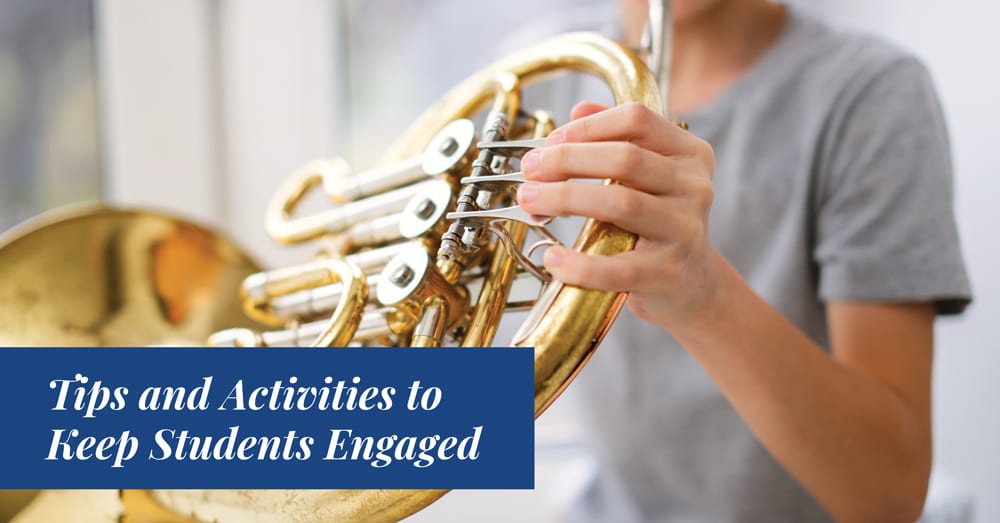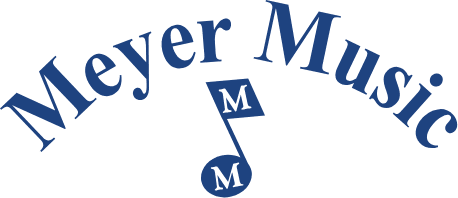Local Music Directors Share Practice Tips and Activities During Social Distancing
Apr 22, 2020

Students are used to working solo in their math, English and science classes. But, how in the world do social-based band and orchestra classes work in the e-learning world of social distancing? Student musicians depend on playing together under the watchful eye (and ear) of their band or orchestra directors to learn and improve.
We spoke to three Kansas City area music teachers and directors about how they’re connecting with their students in a meaningful, productive and positive way. If you’re looking for ideas to practice and improve during social distancing, these teachers will inspire you.
Music Apps and Lessons to Keep Students Practicing and Engaged
Mike Arbucci, Blue Valley Northwest’s orchestra director, is using online technology to keep his students socially connected. Weekly scheduled Zoom conferences give his students the opportunity to interact with one another. Since internet connection lag times make it impossible for students to play together via Zoom, Mr. Arbucci creates discussion boards on Canvas and invites students to reflect on music, post videos of them playing and comment on others’ videos.
All state music competitions were canceled, leaving students who’d practiced for performances without judges’ feedback or awards for hard work. Canvas allowed Mr. Arbucci’s high school orchestra students to virtually watching videos of other districts’ orchestras playing the same music and score their peers. Students could see how the music could be played differently and apply that to their own musicianship.
Mr. Arbucci’s middle school musicians use Canvas to upload their recorded playing tests. Using the platform’s Studio Tool, Mr. Arbucci can freeze the video at any given mark and make constructive comments. His middle and high school students are using Garage Band (Apple application) to record themselves playing sheet music from what was to be their spring concert. Each student plays to a set metronome and the goal is to take the soundtracks and create a version of them playing together.
Blue Valley’s band and orchestra teachers teamed up to keep the district’s elementary musicians engaged in music by making five-minute instructional videos. The videos teach students how to play fun songs they want to learn, such as the theme for Darth Vader or “Baby Shark.”
Elementary parents also have the option of permitting their child to pair with a volunteer high school top orchestra student for one-on-one virtual coaching. Parents simply fill out a request form for their preference of “student” coach and use Zoom or Skype to connect for a “lesson.” Elementary students learn how to play songs, and high school students can earn volunteer hours, plus improve their own playing by diagnosing their mentee.
Idea: Mentorships work for everyone. Pair an older musician with a younger one and set up virtual tutoring sessions.
“Parents are furloughed from work, people are ill… circumstances are difficult. We’re focused on keeping a balance for our students. Everything has been taken away from them at the moment, which especially affects our seniors. We wanted a way to let students feel ownership over something new and important this quarter,” says Mr. Arbucci. “Our choir, band and orchestra teachers approached the administration with the idea to write a new high school alma mater. Once the idea was approved, we commissioned a lyrist and a composer, who got input from students on what they’d like to see in it. We will make a video montage of the new alma mater being sung by our choir and played by the band and orchestra. Also, the performance will be premiered virtually together.”
For parents and band or orchestra students looking for practice activities, Mr. Arbucci recommends:
Sight Reading Factory – This cloud-based program randomly generates rhythm and pitch exercises and can be integrated with Canvas.
Continuing to Improve Musicianship at Students’ Own Pace
Nicole Chapple, district facilitator for Olathe Public Schools, develops continuous learning activities for music students. The Olathe district is taking a different approach to online learning because it has so many students. Rather than asking teachers to work virtually with students in small groups or individually, the district is giving students teacher-designed opportunities (activities) to continue learning on their own time.
For grade 5-8 students, tiered activities reach all levels of learners. Students begin with a basic activity. Once that is completed, they can choose to continue with two additional challenges.
Ms. Chapple emphasizes that practicing is critical, not only for improving but also for social interaction. FaceTiming with a friend in band or orchestra and taking turns playing for each other are a way to practice and give and get feedback.
“Music education can continue on your own. It’s not ideal, but can still be meaningful. Thinking about music if the student wasn’t able to bring their instrument home before the schools were closed… playing music… both can be an emotional release during this time,” explains Ms. Chapple.
Idea: When feeling isolated or stressed, play an instrument. FaceTime with someone who can offer constructive advice or even someone who’ll simply appreciate the music. If real-time FaceTime isn’t an option, share a video of playing.
For continuous learning opportunities in band and orchestra, visit the Olathe Public Schools website. The activities are accessible to anyone, anywhere who is looking for grade-level appropriate music activities. Students as far away as Australia have found the site and are following along with activities posted weekly.
Adapting from the Band Room to Online and Changing Expectations
Cheryl Lee, Blue Valley West’s high school band director, recreates the social nature of the band room for her students using Zoom. Weekly meetings have had a 100 percent attendance rate, even though attendance is not mandatory.
Ms. Lee says, “Our number one goal is keeping students connected to music. The nature of what we do is being together. The band room is band students’ home, where their “people” are and where they can be themselves. Zoom keeps us connected and is how we’re continuing to maintain our connections by talking about what we’ve been listening to.”
She is thankful that her district is leaving online teaching to the teachers’ discretions. For Ms. Lee, that means focusing on individual musicianship, but realizes it’s difficult to manage. She explains, “A lot of students are still practicing daily because they don’t want to get behind. Private lessons are still happening virtually. And, I’m proud we’re still providing learning and connection opportunities.”
Ms. Lee is broadening her band students’ horizons by creating a series of lessons and podcasts on topics such as music transcribing and musical geniuses who’ve dealt with isolation and musical exile, to name a few. After finishing the lessons, students log on to Canvas for discussion. The results so far have been widening the type of music students listen to, and one even has Tchaikovsky Spotify rotation.
Idea: Research musicians from genres you don’t normally listen to and learn more about their influences and style. Many renowned musicians have surprising and interesting pasts, which can influence your musicianship.
Band students can take advantage of a service component of Ms. Lee’s online band class by making videos of themselves playing their instrument. The videos are shared with younger band students, who then feel connected to their future in high school band.
Connecting. Practicing. Adapting. This is What Musicians Do.
There are meaningful ways and supportive tools to help music students connect, practice and adapt to not having music classes at school during “Stay-at-Home” orders. When band and orchestra activities will resume is unknown at this point. While getting back to normal is something everyone looks forward to, for now, music students can take advantage of their band or orchestra teachers’ online curriculum to continue improving their musicianship.

